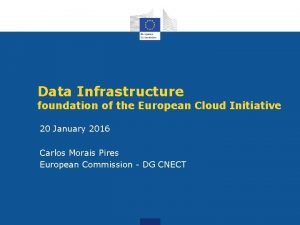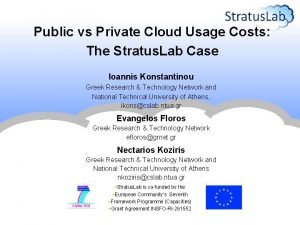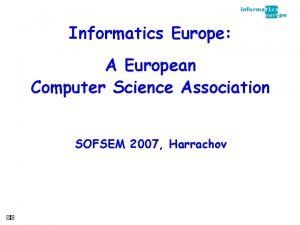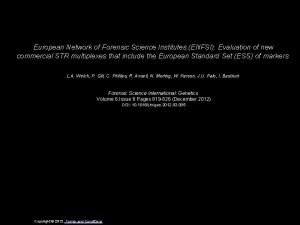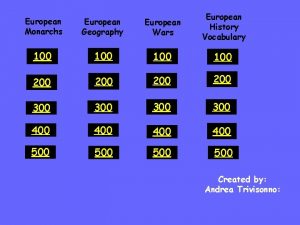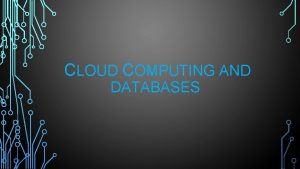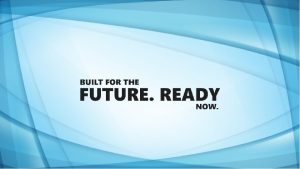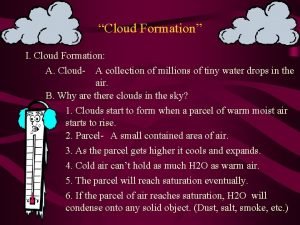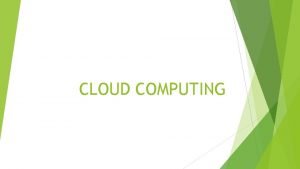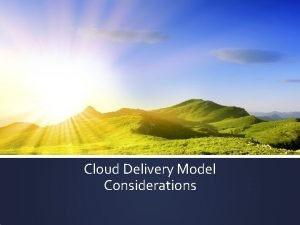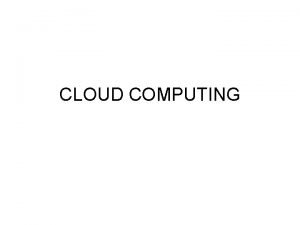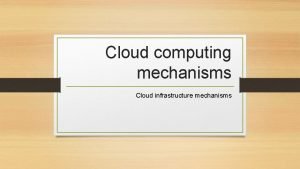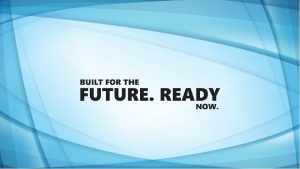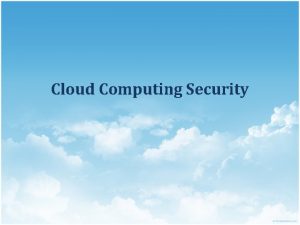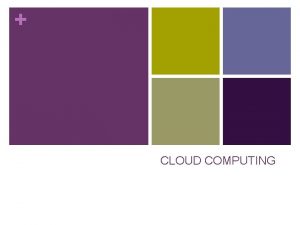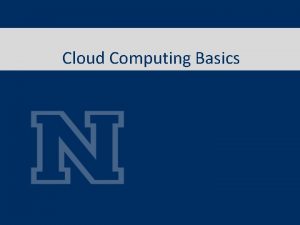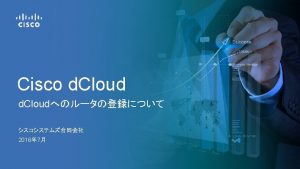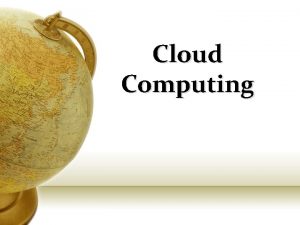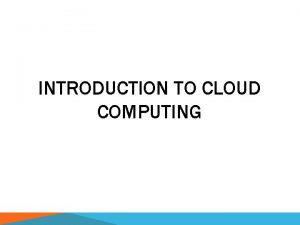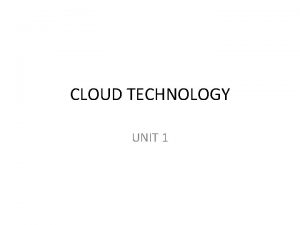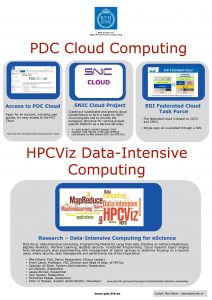Open Science and the European Open Science Cloud

























- Slides: 25

Open Science and the European Open Science Cloud Andreas Veispak European Commission, DG CONNECT

Why do we need Open Science? • Open Science means sharing • knowledge and tools • as early as possible • between researchers and between disciplines, and also with society at large • Open Science has the potential to increase: • Quality and efficiency of R&I, if all the produced results are shared, made reusable, and if their reproducibility is improved; • Creativity, through collective intelligence and cross-disciplinary research that does not require laborious data wrangling; • Trust in the science system, engaging both researchers and citizens.

Main challenges and priorities Improve the practice of research and innovation Develop proper enablers • Openly accessible scholarly publications • Rewards and incentives to adopt Open Science practices, with appropriate metrics • Early sharing of all research outputs • All data FAIR, RDM • Reproducible results • Societal engagement and responsibility • Infrastructures (including EOSC) • Appropriate skills and education, including for research integrity

Progress thus far Council Conclusions (EOSC, knowledge circulation) Council Conclusions (Open Science) 2015 • European Code of Conduct implemented under Grant Agreement H 2020 2016 • Launch OSPP 2017 • OD mandatory in H 2020 (with exceptions) 2018 2019 2020 • HE Regulation • Launch EOSC • OSPP: integrated advice (new metrics to be developed; rewards for OS a priority) • Revised recommendati on on access to scientific information • Plan S launch • Copyright Directive • Open Data Directive • Horizon Europe preparations • EOSC first iteration (201820): governance and operations • Data Strategy Communication • Horizon Europe preparations • Launch ORE • 24 projects, 74 million EU contribution on citizen science projects (Swaf. S) • OSPP report to COMP Council? 2021 Horizo n Europe Launc h

However… • Uncertainty about IPRs and (mis)use – legal, commercial, confidentiality, security, privacy, ethical (and semantic) constraints for sharing and reuse • Researchers generally not rewarded for data management and ‘FAIR-ification’ of data • General gap in skills for data stewardship • Additional resources and tools for data retention, preservation, access, analysis e. g. Text and Data Mining etc. • Technical challenges of integration, e. g. infrastructure, standards

Source: Digital Science and Figshare Report: The State of Open Data 2019

OS practice and research careers Source: EUA, 2019 Open Science survey

Consequently … • Vast majority of data never makes it to a trusted, certified and sustainable repository • Around half of all research data and experiments considered not reproducible • Large differences between disciplines in their approach to data openness, metadata description and uptake of persistent and unique identifiers

Main priorities Immediate • Get Horizon Europe ready • Operationalise EOSC Short term • Support the revision of the rewards & incentives system • Explore responses to the reproducibility crisis • Articulate FAIR “data spaces” to EOSC Medium term • Higher quality and more efficient R&I system

Open Access and Open Research Data in EU R&I programmes 2021 2017 2014 2008 FP 7 OA Pilot Deposit and open access Horizon 2020 OA Mandatory Deposit and open access & ORD/DMP Pilot Horizon 2020 OA Mandatory Deposit and open access & ORD/DMP by default (opt-out) Horizon Europe (TBC) OA Mandatory Deposit and open access DMP in line with FAIR Mandatory ORD by default (exceptions) & Open Science embedded

Open Access and Open Research Data in Horizon Europe Art. 10 - Open Science Art. 35 - Exploitation and Dissemination The approach The modalities Open access to scientific publications to be ensured Open access to scientific publications obligatory: sufficient IPR to be retained Open access to research data to be ensured in line with principle 'as open as possible, as closed as necessary' Open access to research data, 'as open as possible, as closed as necessary' : exceptions Responsible research data management to be ensured in line with FAIR principles Other open science practices to be promoted and encouraged Reciprocity in open science to promoted and encouraged in all association and cooperation agreements with third countries Responsible research data management in line with FAIR principles; Data Management Plan mandatory; possible obligations (in specific WPs) to use the European Open Science Cloud for storing and providing access to data Possible additional incentives or obligations through work programmes for other open science practices

Horizon Europe to walk the talk on Open Science (work in progress) • Publications: Immediate open access; copyright retention and open licenses • Research data: in line with FAIR principles; as open as possible as closed as necessary; mainstreaming of RDM (with DMP) • Emphasis on validation of research results for reproducibility of research as requirement in MGA • Open science practices to be part of proposal evaluation • Mainstreaming co-creation with citizens (including citizen science) • Option through the WP for EOSC

The European Open Science Cloud The role of the EOSC is to ensure that European scientists reap the full benefits of data-driven science, by offering: “ 1. 7 million European researchers and 70 million professionals in science and technology a virtual environment with free at the point of use, open and seamless services for storage, management, analysis and re-use of research data, across borders and scientific disciplines” 2016 Communication on the “European Cloud Initiative” 13

President U. von der Leyen World Economic Forum, Davos, Jan. 22 nd, 2020 • “We are creating a European Open Science Cloud now” • “It is a trusted space for researchers to store their data and to access data from researchers from all other disciplines” • “We will create a pool of interlinked information, a web of research data”

Why the EOSC? • Vehicle for Open Science and the Digital Single Market • Offer researchers anywhere in the EU the resources they need • Build an open and inclusive data commons in Europe and develop a system of FAIR digital objects • Facilitate interdisciplinarity and research to applications • Reduce fragmentation and costs through increased resource sharing and federating existing infrastructures • Enabler of an open, transparent, rule-of-law-based, federated ecosystem, providing access to core digital infrastructure and service resources with the objective of: • • • Maximising digital capacities available to researchers Supporting public authorities in informed policy development and implementation, including for key societal challenges Enable the Digital Single Market, help stimulate the emergence of a competitive EU cloud sector

What is the EOSC? • Trusted and open virtual environment with seamless access to services (with highest TRLs) addressing the whole research data life cycle: • Federate and connect existing or planned RIs • Make data FAIR, store them, ensure long-term preservation • Services to find, access, combine, analyse and process data • Multi-layered federation (federating core, rest of the ecosystem), bringing together supply and demand in a trusted environment • Open, transparent, rule of law based: no lock-in by individual service providers, data portability, IPR, cloud security… • Adaptively user-oriented and inclusive (across borders and disciplines) • Accessible through a non-exclusive, simple, universal access point • Governed by clear and unambiguous Rules of Participation • Steered by an inclusive governance structure

Rationale for EOSC 17

EOSC governance structure 18

EOSC EB Working Groups and Task Forces Landscape WG Sustainability WG Rules of Participation WG Architecture WG FAIR WG Skills & Training WG 19 International Engagement Task Force Communications Task Force EOSC Executive Board Strategic focus Close liaison with Governance Board Practical implementation focused WGs

A first edition of EOSC by end 2020 • Rules of Participation WG: • Agreed and tested Rules of Participation • Landscape WG: • Analysis of existing national infrastructures and policies • Sustainability WG: • Financing model, legal entity, and post 2020 governance structure • Architecture WG: • Functioning federated core • Initial/minimum set of EOSC data and services • EOSC Interoperability Framework (with 20 FAIR WG) • FAIR WG: • Persistent Identifier policy (with Architecture WG) • Metrics for FAIR data and certified services • Training & Skills WG: • EOSC MVP for training & sustainability model (with Architecture WG and Architecture WG) • Recommendation for EOSC skills/training in national digital skills policies

First edition: minimum viable EOSC (MVE) • The MVE includes EOSC-Core (layer of discovery and interoperability) and EOSC-Exchange (layer of enriched services), both of which work with federated FAIR datasets • MVE must enable the federation of existing and planned research data infrastructures • Step 1: Federate thematic clusters and regional projects • Advance incrementally: Begin with simple use cases (open data, rather than sensitive or closed). 21

EOSC-Core: functions and proposed coverage • Provides the means to discover, share, access and re-use data and services (layer of discovery and interoperability) Current discussion on minimum requirements vs. nice to have (Minimum Viable EOSC vs. Maximum Valuable EOSC) • In its first iteration, not planned to store, transport or process data • PID services • To be as widely used as possible: accessible to any authenticated user to promote uptake of EOSC • Service management & access framework 22 Some services under consideration: • AAI framework • Shared open science policy framework • Data access framework • Minimum legal metadata framework • Help-desk

Proposed second and third iterations Public-funded research • All research communities to be tackled by the first iteration under EOSC-Exchange layer • Incremental extensions to target public administration and industry Public sector • Vision: One ‘marketplace’. • Differing requirements/legislation may require linked but alternately governed spaces Private sector 23

Ongoing partnership proposal and SRIA • Current governance of EOSC will present a proposal to the European Commission for a co-programmed partnership under Horizon Europe • The proposed partnership will make the initiative evolve from a project-based approach to an all-encompassing ecosystem where the different stakeholders take the necessary commitments to accomplish it. • Counter-signatory of the Commission will be a legal entity to be set up before the end of the year representing key stakeholders in the EOSC process • Discussions are taking place on how the European Commission, Member States and Associated Countries, and this legal entity of organisations will steer EOSC post 2020 • A Strategic Research and Innovation Agenda will set the long-term strategic priorities and will serve as a handbook for implementing the EOSC vision 24

Thank you 25
 영국 beis
영국 beis Ipcei cloud
Ipcei cloud Which computing refers to applications and services
Which computing refers to applications and services Cloud to cloud integration patterns
Cloud to cloud integration patterns Public cloud vs private cloud cost analysis
Public cloud vs private cloud cost analysis Cloud disaster recovery cloud snap
Cloud disaster recovery cloud snap What is your favorite science subject
What is your favorite science subject European computer science summit
European computer science summit European network of forensic science institutes
European network of forensic science institutes Hát kết hợp bộ gõ cơ thể
Hát kết hợp bộ gõ cơ thể Frameset trong html5
Frameset trong html5 Bổ thể
Bổ thể Tỉ lệ cơ thể trẻ em
Tỉ lệ cơ thể trẻ em Voi kéo gỗ như thế nào
Voi kéo gỗ như thế nào Tư thế worm breton
Tư thế worm breton Chúa yêu trần thế alleluia
Chúa yêu trần thế alleluia Môn thể thao bắt đầu bằng chữ đua
Môn thể thao bắt đầu bằng chữ đua Thế nào là hệ số cao nhất
Thế nào là hệ số cao nhất Các châu lục và đại dương trên thế giới
Các châu lục và đại dương trên thế giới Cong thức tính động năng
Cong thức tính động năng Trời xanh đây là của chúng ta thể thơ
Trời xanh đây là của chúng ta thể thơ Cách giải mật thư tọa độ
Cách giải mật thư tọa độ 101012 bằng
101012 bằng Phản ứng thế ankan
Phản ứng thế ankan Các châu lục và đại dương trên thế giới
Các châu lục và đại dương trên thế giới Thể thơ truyền thống
Thể thơ truyền thống

